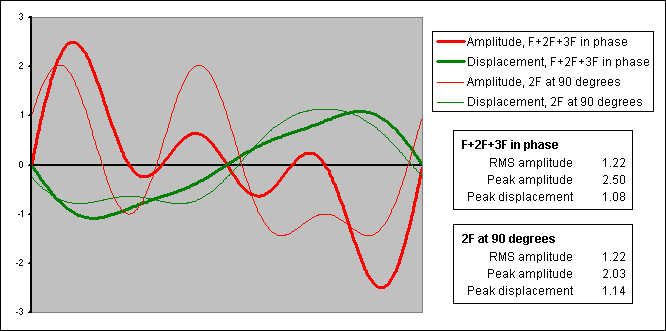Re: Help me understand system limiting- setting it
Hello all. I'm late arriving here. Three thoughts ...
This is a common myth, I'm afraid; signal peaks have little to do with driver excursion. A peak implies a high current for a short time which implies high driver acceleration for a short time. High acceleration for a short time will have little effect on displacement.
The main factor in excursion is low frequency content. For example, imagine a 1kHz sine wave just under a peak limiter threshold with 1 volt crests being fed to a driver, and imagine that this causes an excursion of 1mm. Now give it a 500Hz sine wave instead (an octave lower) still with 1V crests, and you'll find (all else being equal) that the excursion is 4mm. Go to 250Hz, and the excursion is 16mm. This is why drivers often have different power ratings for different low frequency limits.
It depends on the frequency of the bandpass. If the attack time is too fast, it'll mess up the waveform but if it's too slow, the driver will fry before the limiter clamps down. It's typical to set the attack inversely proportionally to the lowest frequency in the bandpass.
It's the time it takes to change gain by some amount, usually 10dB.
Nick
Hello all. I'm late arriving here. Three thoughts ...
However, the reason for peak limiting is to prevent over excursion.
This is a common myth, I'm afraid; signal peaks have little to do with driver excursion. A peak implies a high current for a short time which implies high driver acceleration for a short time. High acceleration for a short time will have little effect on displacement.
The main factor in excursion is low frequency content. For example, imagine a 1kHz sine wave just under a peak limiter threshold with 1 volt crests being fed to a driver, and imagine that this causes an excursion of 1mm. Now give it a 500Hz sine wave instead (an octave lower) still with 1V crests, and you'll find (all else being equal) that the excursion is 4mm. Go to 250Hz, and the excursion is 16mm. This is why drivers often have different power ratings for different low frequency limits.
60 milliseconds is not a slow attack. Attack time for thermal limiting should be seconds.
It depends on the frequency of the bandpass. If the attack time is too fast, it'll mess up the waveform but if it's too slow, the driver will fry before the limiter clamps down. It's typical to set the attack inversely proportionally to the lowest frequency in the bandpass.
I never understood attack and release values with out some reference to dB, i.e. dB/s or s/dB. With just time, no matter how hot the signal is, it's squashed in the same time. Seems this varies across the industry.
It's the time it takes to change gain by some amount, usually 10dB.
Nick
Last edited:

